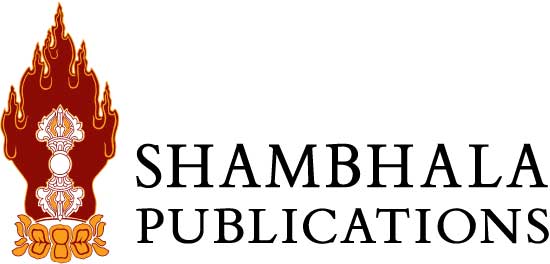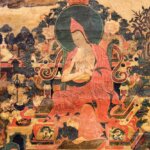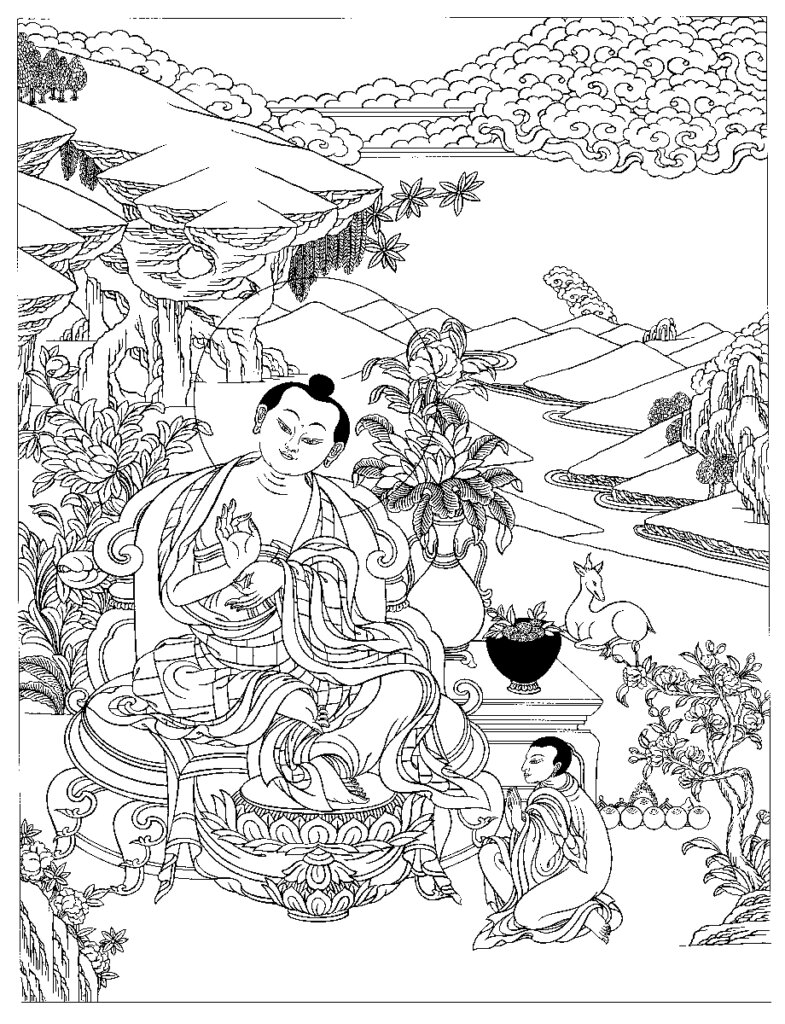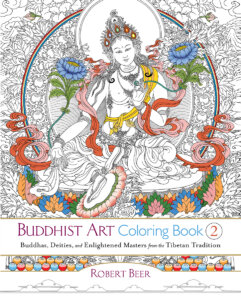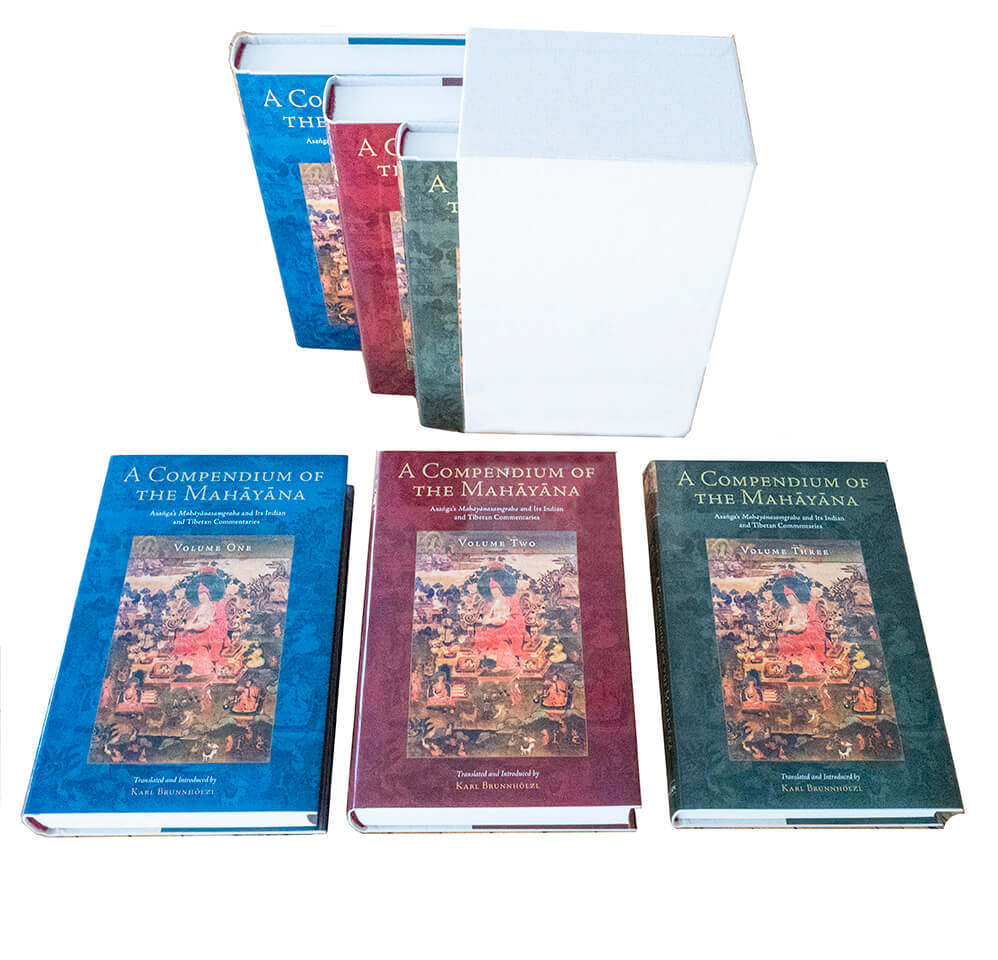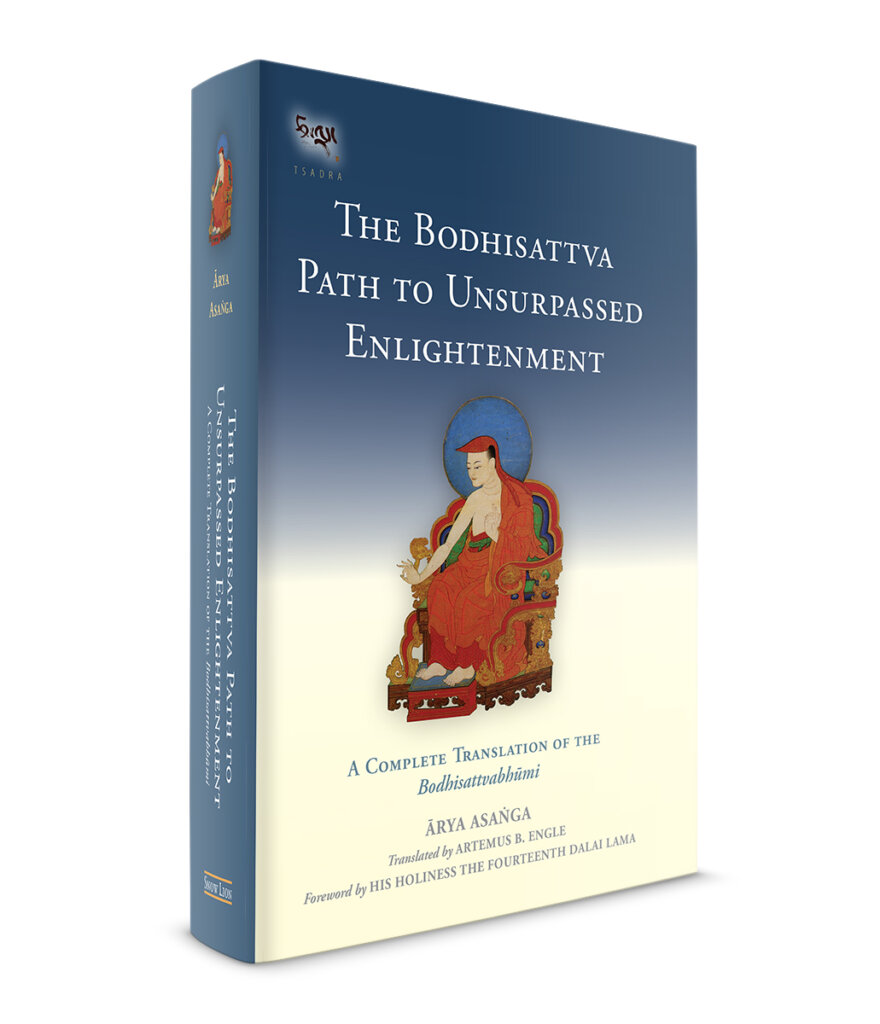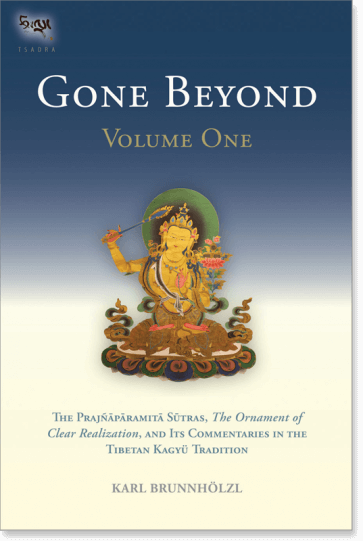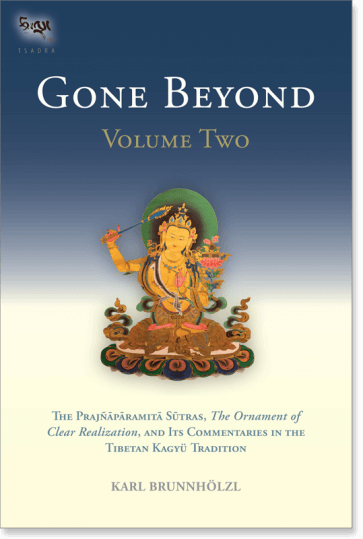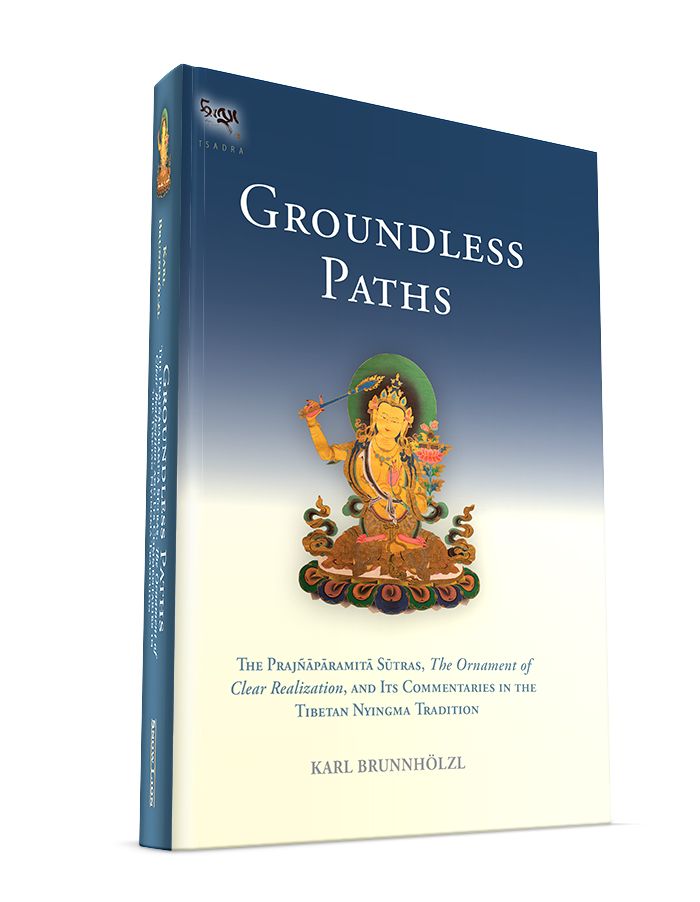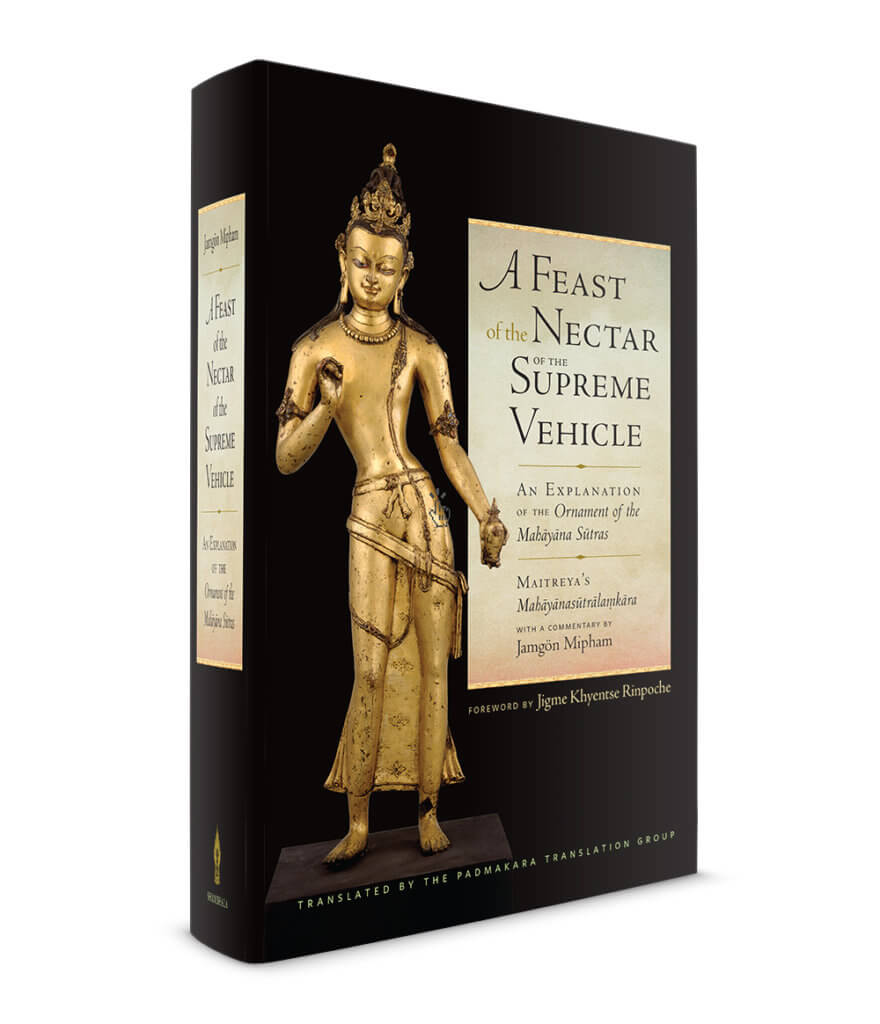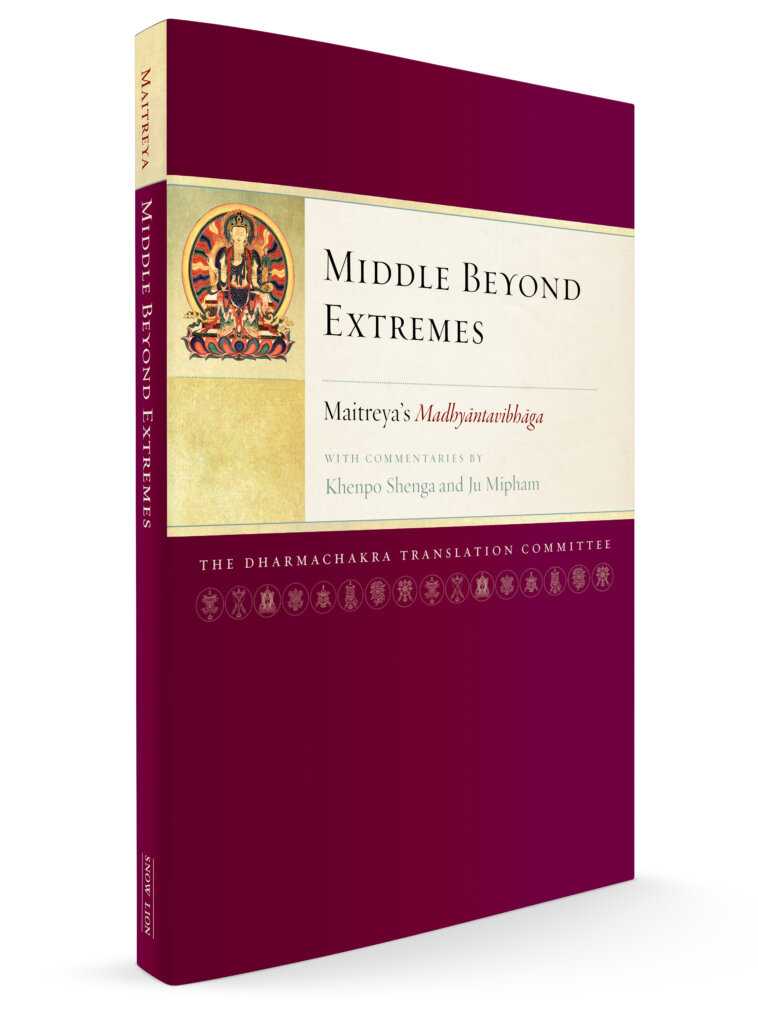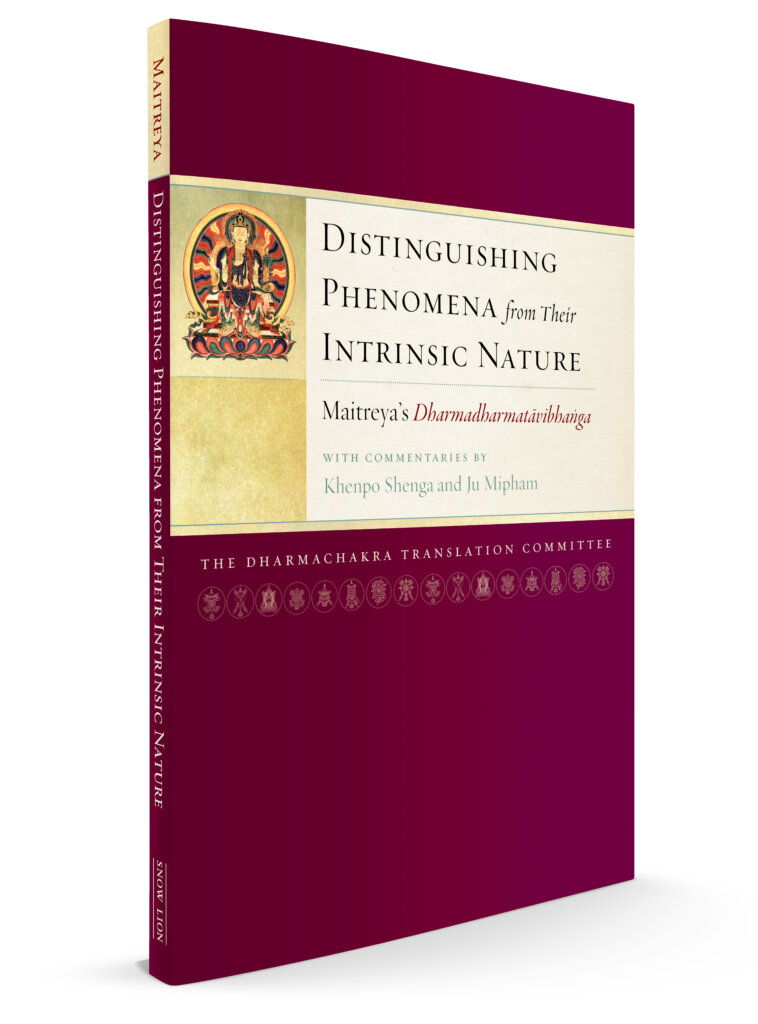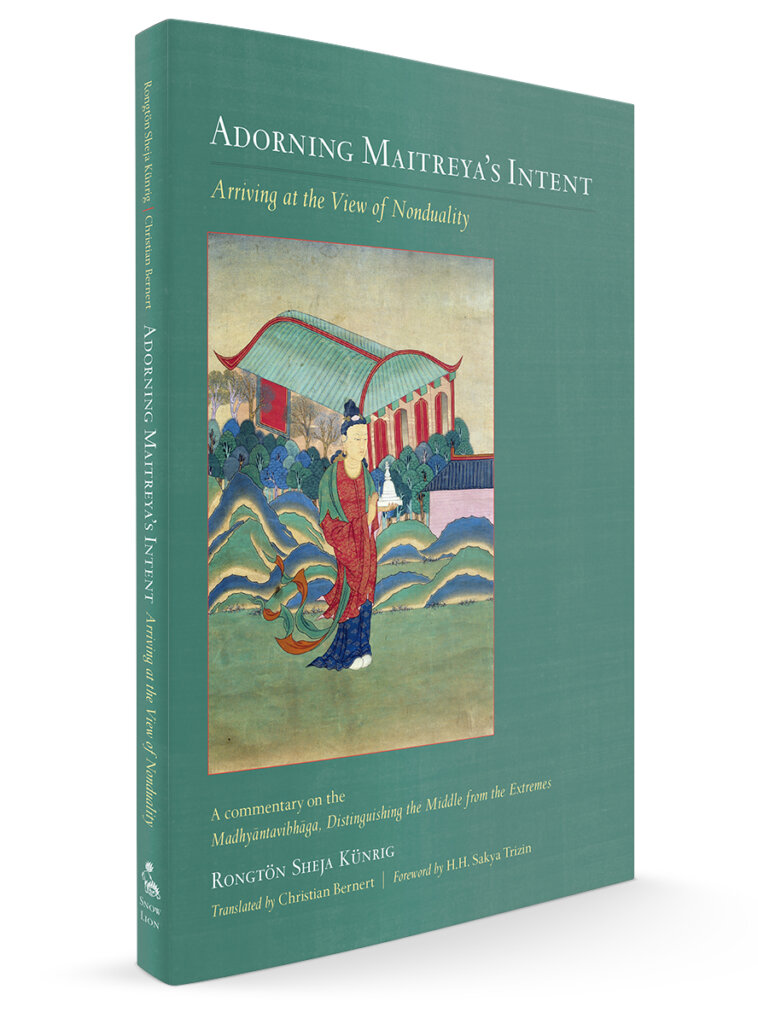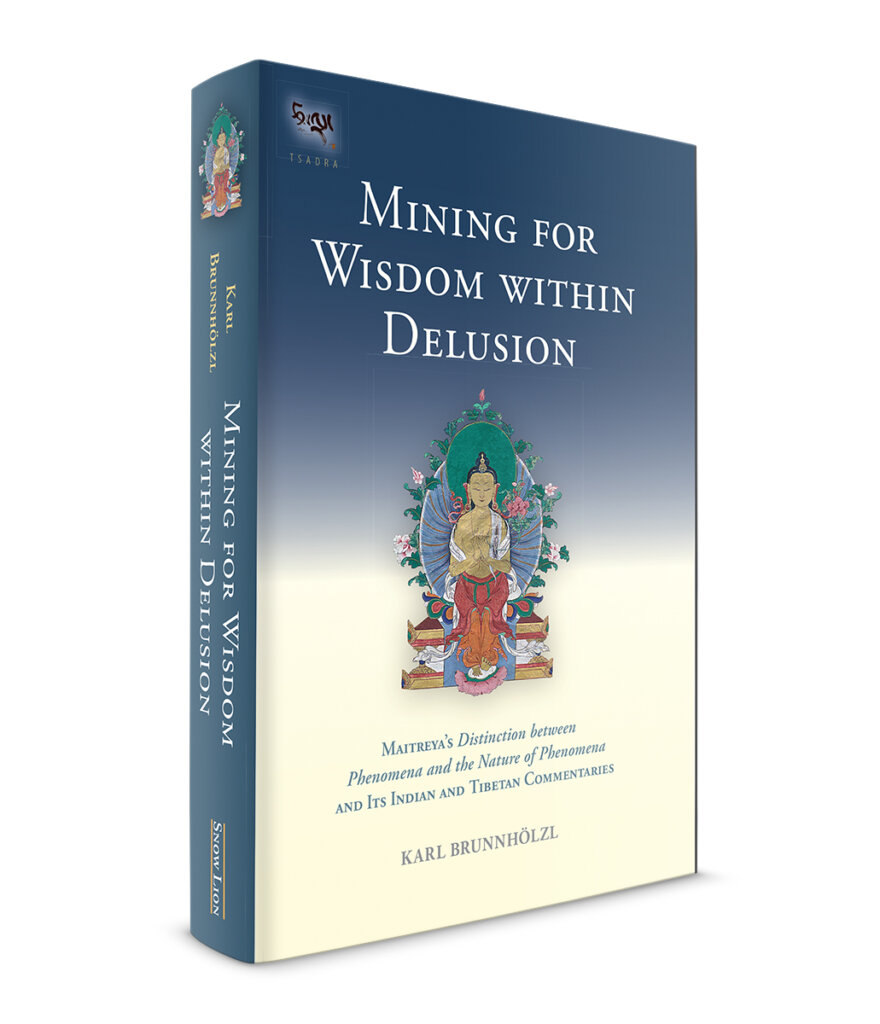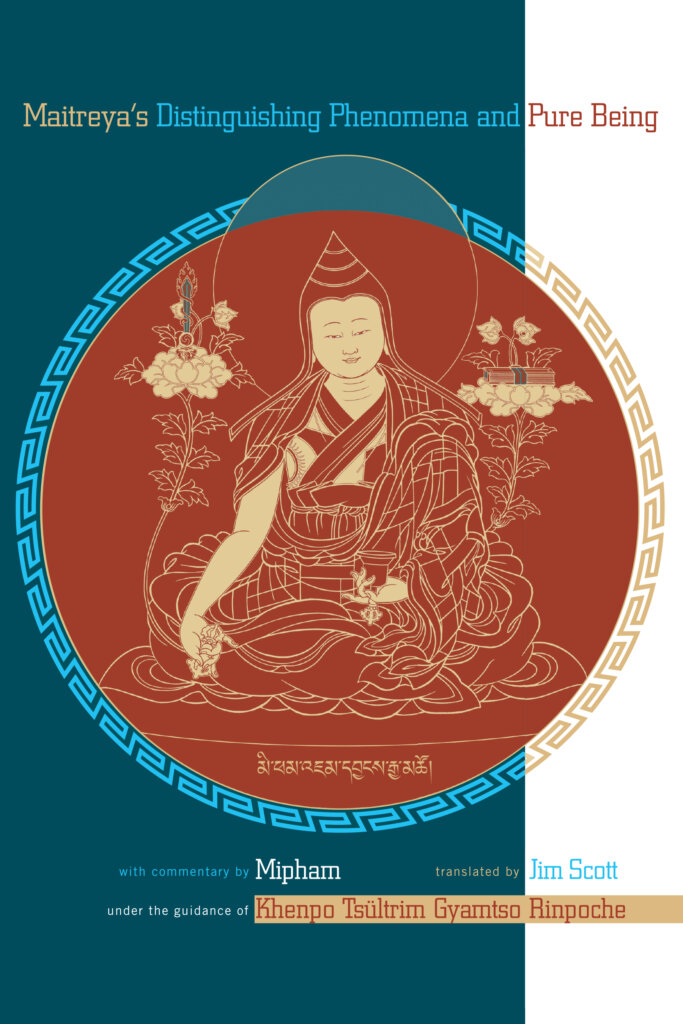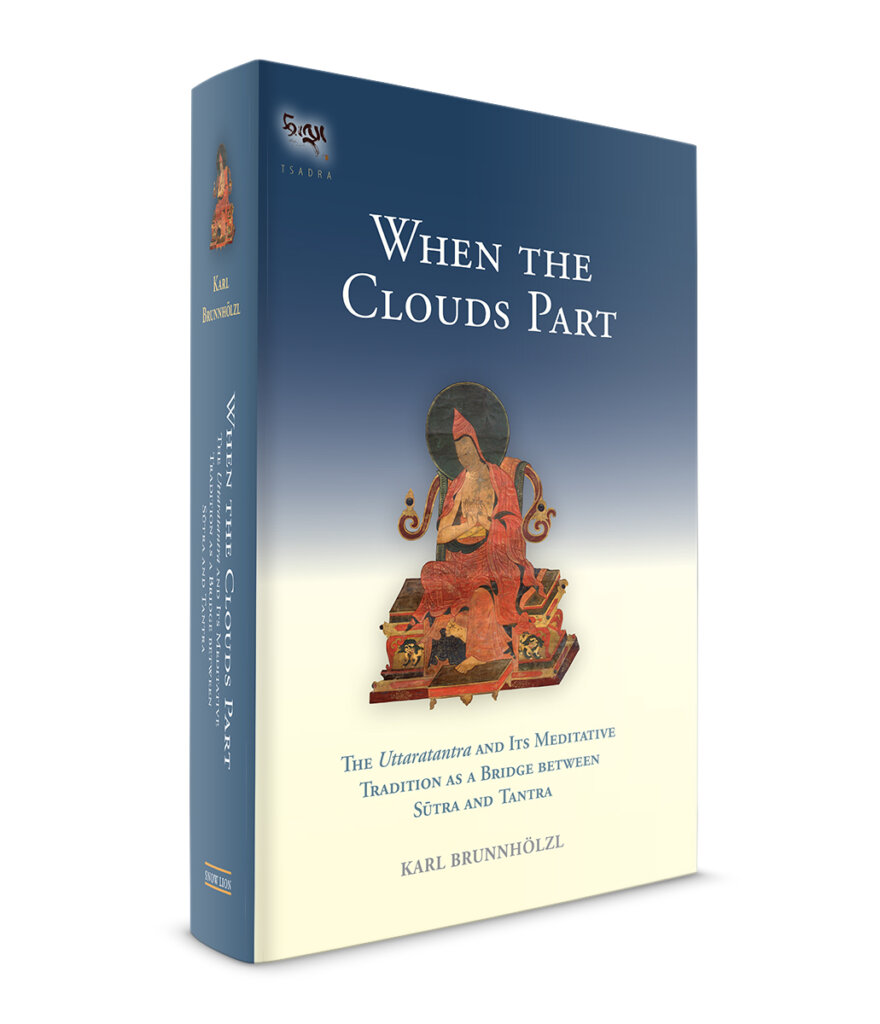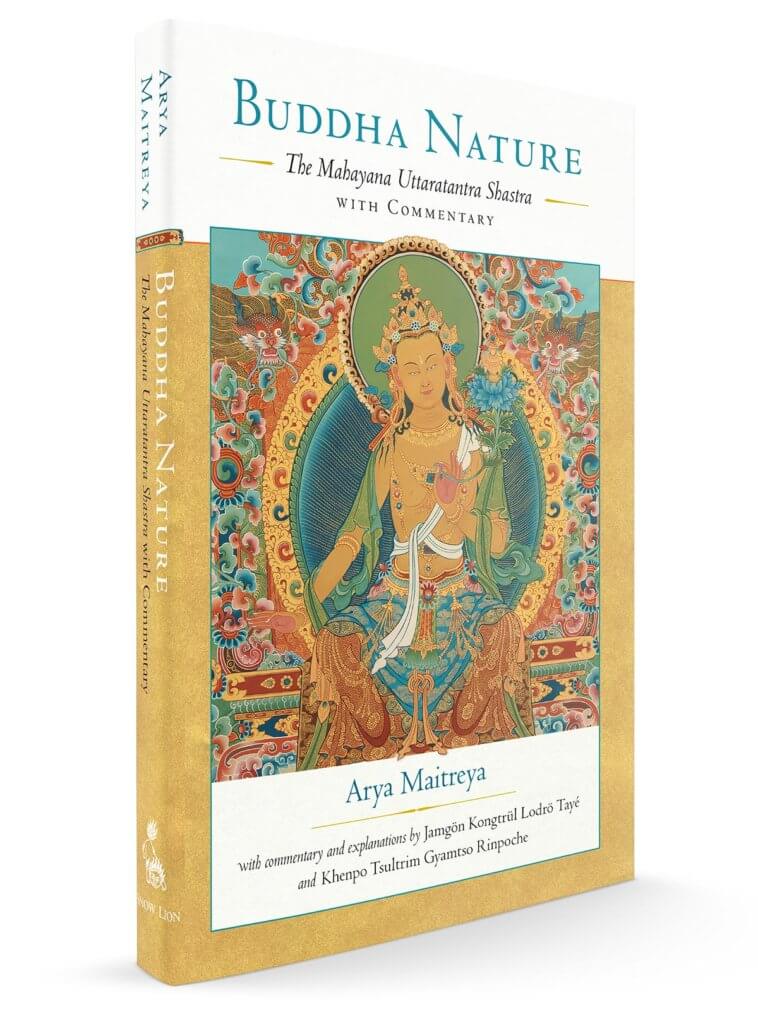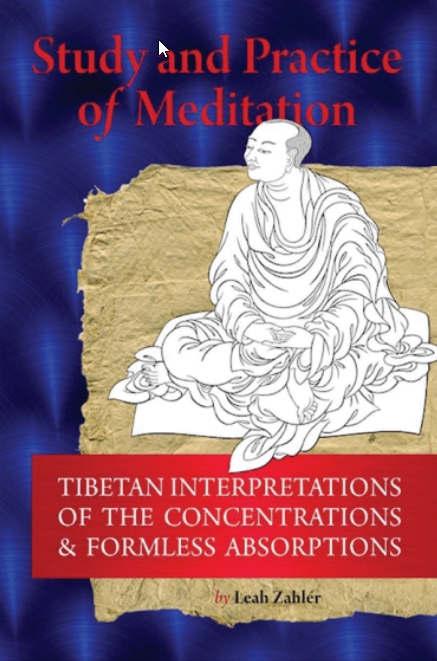Asanga, from The Buddhist Art Coloring Book
Asanga, along with his brother Vasabandu, is an inestimably important figure in Mahayana Buddhism, associated with some of the most important works on ethical and moral dimensions of progress on the path, as well as the Yogacara philosophical school. He is particularly revered in Tibet and East Asia.
Asanga is best known for his two "Summary Treatises" and the teachings he received from Maitreya, the Five Maitreya texts.
The following is from Indestructible Truth: The Living Spirituality of Tibetan Buddhism:
Asanga, considered the founder of the Yogachara school, was born into a Buddhist family in the region of Gandhara in northwestern India.3 As a child, he was drawn strongly to meditation but was also schooled in the major divisions of learning then current in India, including writing, debate, mathematics, medicine, and the fine arts. Asanga was a brilliant student and excelled at whatever he tried. At an early age, he took Buddhist ordination within a Hinayana sect, the Mahishasaka, known for the great importance it attached to the practice of meditation.
Asanga trained under several teachers, mastering the Hinayana scriptures and studying Mahayana sutras. When he encountered the Prajnaparamita sutras, however, he found that while he could read their words, he did not really understand their inner meaning or the awakening they described. Asanga felt compelled by these teachings and recognized that the only way he could gain the transcendent wisdom that he longed for would be to enter into a meditation retreat. Having received instruction from his guru, he now went into strict retreat on Mount Kukkutapada. He spent his time meditating and supplicating his personal deity, the future buddha, Maitreya, for guidance, inspiration, and teaching.
Essential Texts by Asanga
Three Volume Slipcase | Ebook
$150.00 - Hardcover
A Compendium of the Mahayana: Asanga’s Mahayanasamgraha and Its Indian and Tibetan Commentaries
By Karl Brunnholzl
Asanga's The Compendium of the Mahayana, or Mahāyānasaṃgraha, is one of the greatest works expounding the Yogacara teachings of Mahayana. It is also an incrediblefeat of translation, done by master translator and scholar Karl Brunnholzl.
The Mahāyānasaṃgraha, published here with its Indian and Tibetan commentaries in three volumes, presents virtually everything anybody might want to know about the Yogācāra School of Mahāyāna Buddhism. It discusses in detail the nature and operation of the eight kinds of consciousness, the often-misunderstood notion of “mind only” (cittamātra), dependent origination, the cultivation of the path and its fruition in terms of the four wisdoms, and the three bodies (kāyas) of a buddha.
Volume 1 presents the translation of the Mahāyānasaṃgraha along with a commentary by Vasubandhu. The introduction gives an overview of the text and its Indian and Tibetan commentaries, and explains in detail two crucial elements of the Yogācāra view: the ālaya-consciousness and the afflicted mind (klistamanas).
Volume 2 presents translations of the commentary by Asvabhāva and an anonymous Indian commentary on the first chapter of the text. These translations are supplemented in the endnotes by excerpts from Tibetan commentaries and related passages in other Indian and Chinese Yogācāra works.
Volume 3 includes appendices with excerpts from other Indian and Chinese Yogācāra texts and supplementary materials on major Yogācāra topics in the Mahāyānasaṃgraha.
Hardcover | Ebook
$59.95 - Hardcover
The Bodhisattva Path to Unsurpassed Enlightenment: A Complete Translation of the Bodhisattvabhumi
By Asanga, translated by Artemus Engle
Ārya Asanga’s Bodhisattvabhūmi, or The Stage of a Bodhisattva, is the Mahāyāna tradition’s most comprehensive manual on the practice and training of bodhisattvas—by the author’s own account, a compilation of the full range of instructions contained in the entire collection of Mahāyāna sutras. A classic work of the Yogācāra school, it has been cherished in Tibet by all the historical Buddhist lineages as a primary source of instruction on bodhisattva ethics, vows, and practices, as well as for its summary of the ultimate goal of the bodhisattva path—supreme enlightenment.
Despite the text’s seminal importance in the Tibetan traditions, it long remained unavailable in English except in fragments. Engle’s translation, made from the Sanskrit original with reference to the Tibetan translation and commentaries, will enable English readers to understand more fully and clearly what it means to be a bodhisattva and practitioner of the Mahāyāna tradition.
A Deep Dive on the Bodhisattvabhumi
Once you have a copy of The Bodhisattva Path to Unsurpassed Enlightenment, a great complement to reading the book is to watch translator and scholar Artemus Engle discuss the work in detail, offering great context. Watch the preview here for a taste, and then jump right into the two talks, free to all.
Overview and Trailer
Part I, 1.5 Hours
Part II, 2 Hours
The Five Maitreya Texts
See also our two interviews on these texts with Karl Brunnholzl and Thomas Doctor of the Dharmachakra Translation Committee.
The Ornament of Clear Realization: The Abhisamayālaṃkāra
The Abhisamayalamkara summarizes all the topics in the vast body of the Prajnaparamita Sutras. Resembling a zip-file, it comes to life only through its Indian and Tibetan commentaries. Together, these texts not only discuss the "hidden meaning" of the Prajnaparamita Sutras—the paths and bhumis of sravakas, pratyekabuddhas, and bodhisattvas—but also serve as contemplative manuals for the explicit topic of these sutras—emptiness—and how it is to be understood on the progressive levels of realization of bodhisattvas. Thus these texts describe what happens in the mind of a bodhisattva who meditates on emptiness, making it a living experience from the beginner's stage up through buddhahood.
The Ornament of Clear Realization
Karl Brunnholzl discussing the two Gone Beyond volumes on the Kagyu tradition and the Ornament of Clear Realization and Groundless Paths which is the Nyingma take on the same work
Hardcover | Ebook
$54.95 - Hardcover
Gone Beyond (Volume 1)
The Prajnaparamita Sutras, The Ornament of Clear Realization, and Its Commentaries in the Tibetan Kagyu Tradition
By Asanga, Maitreya, the Fifth Shamar Rinpoche, and Karl Brunnholzl
Gone Beyond contains the first in-depth study of the Abhisamayalamkara (the text studied most extensively in higher Tibetan Buddhist education) and its commentaries in the Kagyu School. This study (in two volumes) includes translations of Maitreya's famous text and its commentary by the Fifth Shamarpa Goncho Yenla (the first translation ever of a complete commentary on the Abhisamayalamkara into English), which are supplemented by extensive excerpts from the commentaries by the Third, Seventh, and Eighth Karmapas and others. Thus it closes a long-standing gap in the modern scholarship on the Prajnaparamita Sutras and the literature on paths and bhumis in mahayana Buddhism.
The first volume presents an English translation of the first three chapters of the Abhisamayalamkara and its commentary by the Fifth Shamarpa.
Hardcover | Ebook
$44.95 - Hardcover
Gone Beyond (Volume 2)
The Prajnaparamita Sutras, The Ornament of Clear Realization, and Its Commentaries in the Tibetan Kagyu Tradition
By Asanga, Maitreya, the Fifth Shamar Rinpoche, and Karl Brunnholzl
The second volume presents an English translation of the final five chapters and their commentary by the Fifth Shamarpa.
Hardcover | Ebook
$54.95 - Hardcover
Groundless Paths: The Prajnaparamita Sutras, The Ornament of Clear Realization, and Its Commentaries in the Tibetan Nyingma Tradition
By Asanga, Maitreya, Patrul Rinpoche, Mipham Rinpoche, and Karl Brunnholzl
This study consists mainly of translations of Maitreya's famous text and two commentaries on it by Patrul Rinpoche. These are supplemented by three short texts on the paths and bhumis by the same author, as well as extensive excerpts from commentaries by six other Nyingma masters, including Mipham Rinpoche. Thus this book helps close a long-standing gap in the modern scholarship on the prajñaparamita sutras and the literature on paths and bhumis in mahayana Buddhism.
The Ornament of Mahayana Sutras: The Māhayānasūtrālaṃkāra
Padmakara's Stephen Gethin on the Mahāyānasūtrālaṃkāra
A discussion of the Feast of the Nectar of the Supreme Vehicle and the importance of Mipham Rinpoche's commentary.
Hardcover | Ebook
$54.95 - Hardcover
A Feast of the Nectar of the Supreme Vehicle: An Explanation of the Ornament of the Mahayana Sutras
By Asanga, Mipham Rinpoche. Translated and introduced by the Padmakara Translations Group
A monumental work and Indian Buddhist classic, the Ornament of the Mahāyāna Sūtras (Mahāyānasūtrālamkāra) is a precious resource for students wishing to study in-depth the philosophy and path of Mahāyāna Buddhism. This full translation and commentary outlines the importance of Mahāyāna, the centrality of bodhicitta or the mind of awakening, the path of becoming a bodhisattva, and how one can save beings from suffering through skillful means.
This definitive composition of Mahāyāna teachings was imparted in the fourth century by Maitreya to the famous adept Asanga, one of the most prolific writers of Buddhist treatises in history. Asanga’s work, which is among the famous Five Treatises of Maitreya, has been studied, commented upon, and taught by Buddhists throughout Asia ever since it was composed.
In the early twentieth century, one of Tibet’s greatest scholars and saints, Jamgön Mipham, wrote A Feast of the Nectar of the Supreme Vehicle, which is a detailed explanation of every verse. This commentary has since been used as the primary blueprint for Tibetan Buddhists to illuminate the depth and brilliance of Maitreya’s pith teachings. The Padmakara Translation Group has provided yet another accessible and eloquent translation, ensuring that English-speaking students of Mahāyāna will be able to study this foundational Buddhist text for generations to come.
Distinguishing the Middle from Extremes: The Madhyāntavibhāga
This text explains the vast paths of all three yanas, emphasizing the view of Yogācāra (including the Yogācāra Middle Way) and the distinctive features of the mahāyāna.
Paperback | Ebook
$22.95 - Paperback
Middle Beyond Extremes: Maitreya's Madhyantavibhaga with Commentaries by Khenpo Shenga and Ju Mipham
By Asanga, Khenpo Shenga, Mipham Rinpoche. Translated and introduced by the Padmakara Translations Group
This text employs the principle of the three natures to explain the way things seem to be as well as the way they actually are. It is presented here alongside commentaries by two outstanding masters of Tibet’s nonsectarian Rimé movement, Khenpo Shenga and Ju Mipham.
Distinguishing Phenomena from Their Intrinsic Nature : The Dharmadharmatāvibhāga
This text discusses the difference between samsaric confusion and the liberating power of nonconceptual wisdom-the heart essence of all profound sutras.
Paperback | Ebook
$18.95 - Paperback
Distinguishing Phenomena from Their Intrinsic Nature: Maitreya's Dharmadharmatavibhanga with Commentaries by Khenpo Shenga and Ju Mipham
By Asanga, Maitreya, Khenpo Shenga, Mipham Rinpoche. Translated and introduced by the Dharmachakra Translation Committee
Outlining the difference between appearance and reality, this work shows that the path to awakening involves leaving behind the inaccurate and limiting beliefs we have about ourselves and the world around us and opening ourselves to the limitless potential of our true nature.
By divesting the mind of confusion, the treatise explains, we see things as they actually are. This insight allows for the natural unfolding of compassion and wisdom. This volume includes commentaries by Khenpo Shenga and Ju Mipham, whose discussions illuminate the subtleties of the root text and provide valuable insight into the nature of reality and the process of awakening.
Paperback | Ebook
$24.95 - Paperback
Adorning Maitreya’s Intent: Arriving at the View of Nonduality
By Asanga, Maitreya, Rongtonpa, introduced and translated by Christian Bernert
Here, the Tibetan master Rongtön unpacks this manual and its practices for us in a way that is at once accessible and profound, with actual practical meditative applications. The work explains the vast paths of the three vehicles of Buddhism, emphasizing the view of Yogācāra, and demonstrates the inseparability of experience and emptiness. It offers a detailed presentation of the three natures of reality, an accurate understanding of which provides the antidotes to confusion and suffering. The translator’s introduction presents a clear overview of all the concepts explored in the text, making it easy for the reader to bridge its ideas to actual practice.
Hardcover | Ebook
$39.95 - Hardcover
Mining for Wisdom within Delusion: Maitreya's Distinction between Phenomena and the Nature of Phenomena and Its Indian and Tibetan Commentaries
By Asanga, Maitreya, Vasabandhu, Gö Lotsāwa, The Third Karmapa Rangjung Dorje, . Translated and introduced by Karl Brunnholzl.
Maitreya’s Distinction between Phenomena and the Nature of Phenomena distinguishes the illusory phenomenal world of saṃsāra produced by the confused dualistic mind from the ultimate reality that is mind’s true nature. The transition from the one to the other is the process of “mining for wisdom within delusion.” Maitreya’s text calls this “the fundamental change,” which refers to the vanishing of delusive appearances through practicing the path, thus revealing the underlying changeless nature of these appearances. In this context, the main part of the text consists of the most detailed explanation of nonconceptual wisdom—the primary driving force of the path as well as its ultimate result—in Buddhist literature.
The introduction of the book discusses these two topics (fundamental change and nonconceptual wisdom) at length and shows how they are treated in a number of other Buddhist scriptures. The three translated commentaries, by Vasubandhu, the Third Karmapa, Rangjung Dorje, and Gö Lotsāwa, as well as excerpts from all other available commentaries on Maitreya’s text, put it in the larger context of the Indian Yogācāra School and further clarify its main themes. They also show how this text is not a mere scholarly document, but an essential foundation for practicing both the sūtrayāna and the vajrayāna and thus making what it describes a living experience. The book also discusses the remaining four of the five works of Maitreya, their transmission from India to Tibet, and various views about them in the Tibetan tradition.
Paperback | Ebook
$24.95 - Paperback
Maitreya's Distinguishing Phenomena and Pure Being
By Asanga, Maitreya, and Mipham Rinpoche. Translated by Jim Scott under the guidance of Khenpo Tsultrim Gyamtso.
Maitreya’s Distinction between Phenomena and the Nature of Phenomena distinguishes the illusory phenomenal world of saṃsāra produced by the confused dualistic mind from the ultimate reality that is mind’s true nature. The transition from the one to the other is the process of “mining for wisdom within delusion.” Maitreya’s text calls this “the fundamental change,” which refers to the vanishing of delusive appearances through practicing the path, thus revealing the underlying changeless nature of these appearances. In this context, the main part of the text consists of the most detailed explanation of nonconceptual wisdom—the primary driving force of the path as well as its ultimate result—in Buddhist literature.
The introduction of the book discusses these two topics (fundamental change and nonconceptual wisdom) at length and shows how they are treated in a number of other Buddhist scriptures. The three translated commentaries, by Vasubandhu, the Third Karmapa, Rangjung Dorje, and Gö Lotsāwa, as well as excerpts from all other available commentaries on Maitreya’s text, put it in the larger context of the Indian Yogācāra School and further clarify its main themes. They also show how this text is not a mere scholarly document, but an essential foundation for practicing both the sūtrayāna and the vajrayāna and thus making what it describes a living experience. The book also discusses the remaining four of the five works of Maitreya, their transmission from India to Tibet, and various views about them in the Tibetan tradition.
The Sublime Continuum: The Uttaratantra Śāstra
Also known as the Ratnagotravibhāga Mahāyānottaratantraśāstra, this is a general commentary on buddha nature and represents a bridge between sutra and tantra.
Hardcover | Ebook
$49.95 - Hardcover
When the Clouds Part: The Uttaratantra and Its Meditative Tradition as a Bridge between Sutra and Tantra
By Asanga, Karl Brunnholzl, Mipham Rinpoche, Pema Karpo, Mönlam Tsültrim, Eighth Karmapa, Jamgon Kongtrul and more.
This book discusses a wide range of topics connected with the notion of buddha nature as presented in Indo-Tibetan Buddhism and includes an overview of the sūtra sources of the tathāgatagarbha teachings and the different ways of explaining the meaning of this term. It includes new translations of the Maitreya treatise Mahāyānottaratantra (Ratnagotravibhāga), the primary Indian text on the subject, its Indian commentaries, and two (hitherto untranslated) commentaries from the Tibetan Kagyü tradition. Most important, the translator’s introduction investigates in detail the meditative tradition of using the Mahāyānottaratantra as a basis for Mahāmudrā instructions and the Shentong approach. This is supplemented by translations of a number of short Tibetan meditation manuals from the Kadampa, Kagyü, and Jonang schools that use the Mahāyānottaratantra as a work to contemplate and realize one’s own buddha nature.
Paperback | Ebook
$34.95 - Paperback
Buddha Nature: The Mahayana Uttaratantra Shastra with Commentary
By Maitreya, Asanga, Jamgon Kongtrul, Khenpo Tsultrim Gyamtso, translated by Rosemarie Fuchs
All sentient beings, without exception, have buddha nature—the inherent purity and perfection of the mind, untouched by changing mental states. Thus there is neither any reason for conceit nor self-contempt. This is obscured by veils that are removable and do not touch the inherent purity and perfection of the nature of the mind. The Mahayana Uttaratantra Shastra, one of the “Five Treatises” said to have been dictated to Asanga by the Bodhisattva Maitreya, presents the Buddha’s definitive teachings on how we should understand this ground of enlightenment and clarifies the nature and qualities of buddhahood. This seminal text details with great clarity the view that forms the basis for Vajrayana, and especially Mahamudra, practice.
Paperback | Ebook
$39.95 - Paperback
Study and Practice of Meditation
Tibetan Interpretations of the Concentrations and Formless Absorptions
By Leah Zahler
Study and Practice of Meditation gives a vivid and detailed account of the meditative practices necessary to develop a calm, alert mind that is capable of penetrating the depths of reality. The Buddhist meditative states known as the concentrations and formless absorptions are best known in the West from Theravada scriptures and from Vasubandhu’s Treasury of Manifest Knowledge. Asanga's Summary of Manifest Knowledge (abhidharmasamuccaya, mngon pa kun btus) and his Grounds of Hearers (śrāvakabhūmi, nyan sa)also feature heavily.
In this book the reader is exposed to Tibetan Buddhist views on the mental states attained through meditation as described by three Geluk lamas. The book discusses the ways in which certain meditative states act as bases of the spiritual path as well as the nature of meditative calm and the prerequisites for cultivating and attaining it. In addition to reviewing and translating Tibetan sources, the author considers their major Indian antecedents and draws comparisons with Theravadin presentations.
Additional Resources on Asanga
On Lotsawa House Asanga appears in many translations, generally as a figure in a prayer. 

